
Hydrangea Mophead
The Classic: Mophead Hydrangeas
Mophead Hydrangeas or Hydrangea macrophylla are one of the most beloved flowering shrub choices for Southern gardens. Imagine summer evenings on your patio, sipping your sweet tea and enjoying grand flower clusters of blues, reds, and purples highlighted by lush green foliage. Flower blooms as big as grapefruits perfect in your landscape and for cutting to make your own fresh bouquet.
The most popular type of hydrangeas; they are a deciduous woody shrub with most varieties growing between 3 to 5 feet tall. These hydrangeas begin to leaf out as early as mid-March April. By June or July, the hydrangea buds will start to appear. By mid-summer and into fall these plants will give off some of the most beautiful blooms in your garden. They are grand in the landscape but can also be grown in large pots.
Your Favorite Mophead Hydrangeas
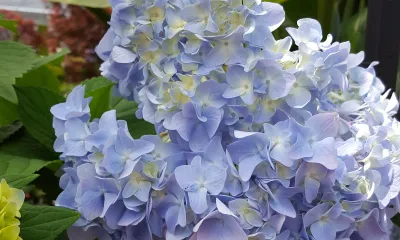
Hydrangea Endless Summer® The Original
One of the first reblooming
mophead hydrangeas, it continues to be a favorite with large, vibrant flowers
that bloom on old wood & new wood. It thrives in partial shade and grows
four feet tall and wide. With an abundance of blooms treat yourself by cutting
some for your kitchen or bedroom.
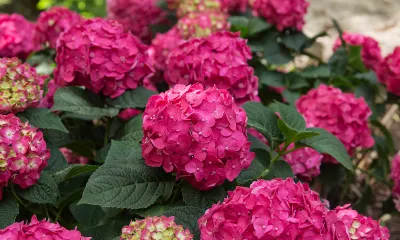
Hydrangea Endless Summer® Summer Crush
Enjoy breathtaking vibrant
pink blooms from early summer through fall. It's not just a pretty face; this beauty
is low maintenance and prefers partial shade. It grows just 2-3 feet tall and
wide making it a great shrub for landscapes of every size.
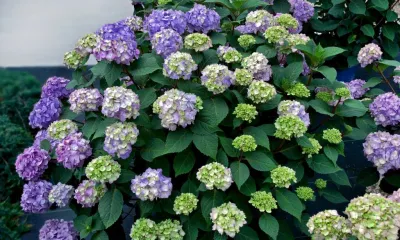
Hydrangea Endless Summer® BloomStruck
The huge blue-purple
clusters of blooms pop in the garden and make the perfect cut flower with their
extra sturdy long stems. Plant in partial sun and watch as it grows 3-4 feet
tall and 4-5 feet wide.
Hydrangea Azure Skies™
The cool-blue clusters of flowers
will bloom in your landscape from early summer through fall. A partial sun
lover, this hydrangea makes its mark in the landscape growing 5-6 feet tall and
wide.
Hydrangea Rock ‘n Roll™
The large cluster of flowers
comes in bright pink, purple, and a dreamy bloom. In our soil, they tend to be
a purple-blue color that brightens up any partial shade area. It has a nice
round form, growing 4-5 feet tall and wide.
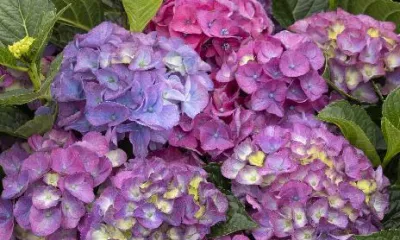
Hydrangea Seaside Serenade® Newport
Bring Newport Beach vibes to
your landscape with clusters of violet blooms with creamy-yellow centers. With blooms
from early summer through fall, you'll have plenty to cut for long-lasting
flower arrangements. Plant in partial shade and it'll grow four feet tall and
wide.
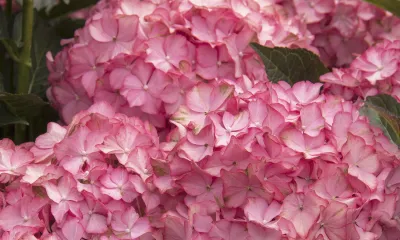
Hydrangea Seaside Serenade® Hampton
Lavish in huge globes of
pink florets on long, sturdy stems perfect for cutting. If the flowers weren't
enough, the foliage is a beautiful maroon in spring and turns to cinnamon-red
for fall. Plant in partial sun where it'll quickly grow to 3-4 feet tall and 3
feet wide.
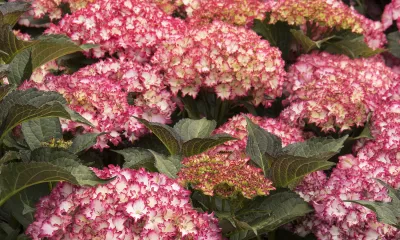
Hydrangea Seaside Serenade® Fire Island
Pretty white ruffled flowers
edged in pink pop in the landscape and repeat bloom from spring through summer.
The flowers are offset by their maroon foliage in spring and fall. It grows
three feet tall and wide in partial shade.
Hydrangea Endless Summer® Pop Star™
The newest member of the
beloved Endless Summer series, popstar earns its name with clusters of large
flowers in purple-pink that rebloom faster for an almost continuous show of flowers
from spring through fall. The stems are even longer giving you the ultimate cut
flower. This beauty stays nice and compact growing three feet tall and wide. Plant
in partial sun.
Step-by-Step Planting Instructions
Mophead hydrangeas can be planted in the landscape or in a
container. Here are the steps for planting hydrangeas in your landscape.
1. Dig a hole twice the size of
the hydrangea pot.
2. Remove the native soil from
the hole and mix it at a 50-50 ratio with Black Gold Planting Mix. Our native
clay soil is compact and dense. It's critical to amend it with a rich, organic
planting mix to break up the soil to allow for root development and proper
drainage as well as add needed organic matter.
3. Backfill the hole to the size
of your hydrangea container and add a handful of Dr. Earth Root Zone Organic
Starter Fertilizer to the hole. This will help give your new hydrangea key
vitamins for root development and prevents transplant shock.
4. Holding the base of the
hydrangea; remove it from the grower's pot and place it in the hole.
5. Backfill the hole with the
amended soil and gently press the top of the soil to remove air pockets. The
soil line from the pot should be even with the soil level in your garden; be
sure not to plant too deep or too shallow.
6. Give your newly planted
hydrangea a good watering to help it get comfy and cozy in its new home.
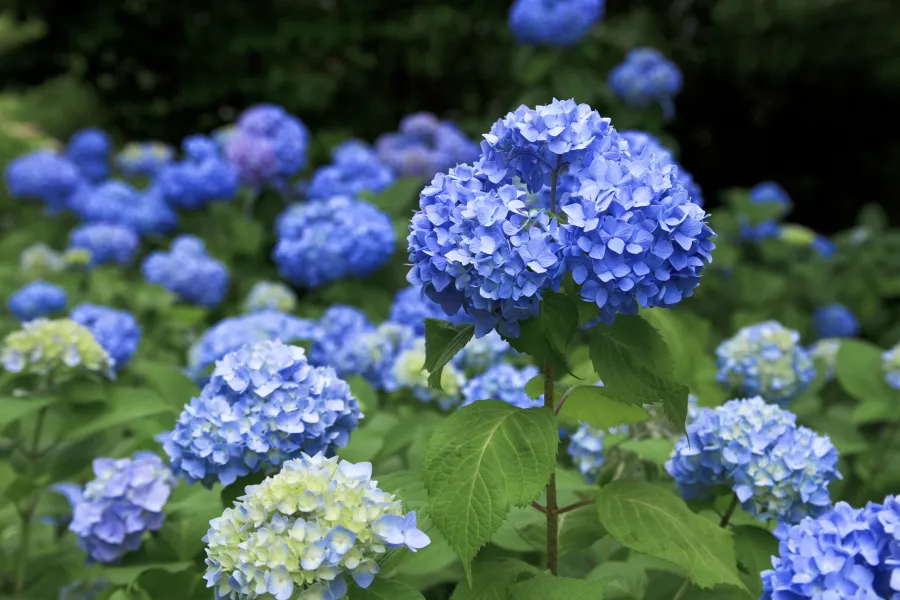
Water Needs
Hydrangeas are thirsty;
especially while they are establishing in your landscape. Foliage may wilt on
our hot summer nights but rebound in the morning. To help keep your hydrangea
cooler and retain moisture, apply a two-inch layer of mulch around your
hydrangeas. Avoid getting water on the foliage in the afternoon as the water on
the leaves can cause scorch. Proper and best watering times are best in the
morning between 6am-10am.
Pruning
The best time
to prune your Mophead Hydrangea is shortly following the blooming period;
typically in early to mid-fall. An ample pruning would be cutting your
hydrangea to a third of the size of the plant. This is not critical but will
give you a healthier, better-shaped plant. Avoid pruning anytime leading into
spring as you will be cutting off soon-to-be buds. Dead branches can be trimmed
throughout the year and are easily spotted as the plants leaf out in Spring.
Why isn't my hydrangea?
Your hydrangea
not blooming is typically one of two things: not enough sunlight or it needs
nutrients. Even though they are a shade shrub, hydrangeas need morning sunlight
to give them the energy to produce blooms. If your hydrangea is producing
minimal flowers, it's telling you it needs to be fertilized. Start your feeding
schedule in early spring when you start to see the foliage emerge and continue
feeding until it stops producing blooms. We recommend feeding your hydrangeas
with Dr. Earth Acid-Lovers Organic fertilizer. It's an easy-to-apply organic
granular fertilizer that should be applied every two months as directed.
Why are there spots on my hydrangea?
Being
a water-lover, hydrangeas are susceptible to black spot and other fungal
issues. To prevent or treat fungal issues apply a systemic fungicide like
Bonide Infuse. By September the transition into fall and the leaf spot is
inevitable. Foliage will turn shades of dark red and purple, with these spots
before falling off.
Whyare the leaves drooping?
This is common
during the hottest summer days and is a sign that your hydrangea is thirsty.
Water your hydrangea in the morning between 6am-10am and you should see your hydrangea
perk up.



